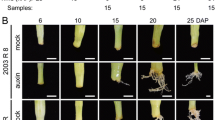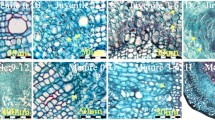Abstract
In woody plants, the juvenile-to-adult transition occurs when the apical and lateral branches reach a sufficient distance from the roots. In olive trees, there is a minimum distance required between the root and the meristem for flowering to occur. However, the way in which the roots may influence the apical meristem to develop juvenile or adult branches is still unknown; despite that, it is of great relevance for breeders. In addition, as in most fruit trees, olive cultivars are propagated by cuttings, while genetic breeding is performed by seedlings. The roots of both types of plants, cuttings, and seedlings, originate from different tissues, giving rise to differences between the two types of roots. For these reasons, we have studied the gene expression differences between the two types of roots in olive plants by microarray hybridization and found 253 genes differentially expressed, 126 over-expressed in roots of adult cuttings, and 127 in roots of juvenile seedlings. The genes over-expressed in cutting roots showed a similar distribution of genes in metabolic and biosynthetic processes, but juvenile seedling roots showed 20 % of over-expressed genes associated with lipid biosynthesis and metabolism processes, while these processes were absent in the over-expressed genes of adult cutting roots and in general, seedling over-expressed root genes are more diverse and evenly distributed than in cutting roots. In addition, eight root-specific genes have been identified.







Similar content being viewed by others
References
Aldwinckle HS (1975) Flowering of apple seedlings 16–20 months after germination. HortSci 10:124–126
Badenes ML, Byrne DH (2012) Fruit breeding. Springer Science+Business Media, New York
Bellini E (1990) Behavior of some genetic characters in olive seedlings obtained by cross-breeding. Fruit Breed Genet 317:197–208
Bellini E (1993) Genetic variability and heritability of some characters in cross-bred olive seedlings. Olivae 49:21–34
Bernal AJ, Yoo CM, Mutwil M, Jensen JK, Hou G, Blaukopf C, Sørensen I, Blancaflor EB, Scheller HV, Willats WGT (2008) Functional analysis of the cellulose synthase-like genes CSLD1, CSLD2, and CSLD4 in tip-growing Arabidopsis cells. Plant Physiol 148:1238–1253
Cairns JRK, Esen A (2010) β-glucosidases. Cell Mol Life Sci 67:3389–3405
Carpenter JL, Ploense SE, Snustad DP, Silflow CD (1992) Preferential expression of an alpha-tubulin gene of Arabidopsis in pollen. Plant Cell 4:557–571
Conesa AS, Götz JM, García-Gómez J, Terol M, Talón M, Robles M (2005) Blast2GO: a universal tool for annotation, visualization and analysis in functional genomics research. Bioinformatics 21:3674–3676
Daehler CC, Yorkston M, Sun W, Dudley N (1999) Genetic variation in morphology and growth characters of Acacia koa in the Hawaiian Islands. Int J Plant Sci 160:767–773
Davin LB, Lewis NG (2000) Dirigent proteins and dirigent sites explain the mystery of specificity of radical precursor coupling in lignan and lignin biosynthesis. Plant Physiol 123:453–462
De la Rosa R, Kiran AI, Barranco D, León L (2006) Seedling vigour as a preselection criterion for short juvenile period in olive breeding. Crop Pasture Sci 57:477–481
Favery B, Ryan E, Foreman J, Linstead P, Boudonck K, Steer M, Shaw P, Dolan L (2001) KOJAK encodes a cellulose synthase-like protein required for root hair cell morphogenesis in Arabidopsis. Genes Dev 15:79–89
Fernández-Ocaña A, García-López MC, Jiménez-Ruiz J, Saniger L, Macías D, Navarro F, Oya R, Belaj A, de la Rosa R, Corpas FJ (2010) Identification of a gene involved in the juvenile-to-adult transition (JAT) in cultivated olive trees. Tree Genet Genomes 6:891–903
Flores HE, Vivanco JM, Loyola-Vargas VM (1999) ‘Radicle’ biochemistry: the biology of root-specific metabolism. Trends Plant Sci 4:220–226
García-López MC, Vidoy I, Jiménez-Ruiz J, Muñoz-Mérida A, Fernández-Ocaña A, de la Rosa R, Barroso JB, Navarro F, Trelles O, Beuzón CR, Barceló A, Valpuesta V, Luque F (2014) Genetic changes involved in the juvenile-to-adult transition in the shoot apex of Olea europaea L. occur years before the first flowering. Tree Genet Genomes 10:585–603
Hackett WP (1985) Juvenility, maturation and rejuvenation in woody plants. Hortic Rev 7:109–155
Hartmann HT, Kester DE, Davies JFT, Geneve RL (2002) Plant propagation: principles and practices, 7th edn. Prentice Hall, Upper Saddle River
Jeon JS, Lee S, Jung KH, Jun SH, Kim CM, An G (2000) Tissue-preferential expression of a rice α-tubulin gene, OsTubA1, mediated by the first intron. Plant Physiol 123:1005–1014
Joyce CM, Villemur R, Snustad DP, Silflow CD (1992) Tubulin gene expression in maize (Zea mays): change in isotype expression along the developmental axis of seedling root. J Mol Biol 227:97–107
Kim CM, Park SH, Je B, Park SH, Park SJ, Piao HL, Eun MY, Dolan L, Han C (2007) OsCSLD1, a cellulose synthase-like D1 gene, is required for root hair morphogenesis in rice. Plant Physiol 143:1220–1230
Langmead B, Salzberg SL (2012) Fast gapped-read alignment with bowtie 2. Nat Methods 9:357–359
Lavee S, Avidan N, Haskal A, Ogrodovich A (1996) Juvenility period reduction in olive seedlings: a tool for enhancement of breeding. Olivae 60:33–41
Leyva-Pérez MO, Valverde-Corredor A, Valderrama R, Jiménez-Ruiz J, Muñoz-Mérida A, Trelles O, Barroso JB, Mercado-Blanco J, Luque F (2015) Early and delayed long-term transcriptional changes and short-term transient responses during cold acclimation in olive leaves. DNA Res 22:1–11
Li M, Xiong G, Li R, Cui J, Tang D, Zhang B, Pauly M, Cheng Z, Zhou Y (2009) Rice cellulose synthase‐like D4 is essential for normal cell‐wall biosynthesis and plant growth. Plant J 60:1055–1069
Luan W, Liu Y, Zhang F, Song Y, Wang Z, Peng Y, Sun Z (2011) OsCD1 encodes a putative member of the cellulose synthase‐like D sub‐family and is essential for rice plant architecture and growth. Plant Biotechnol J 9:513–524
Moreno-Alías I, Rapoport HF, León L, de la Rosa R (2010) Olive seedling first-flowering position and management. Sci Hortic-Amst 124:74–77
Muñoz-Mérida A, González-Plaza JJ, Blanco AM, García-López MC, Rodríguez JM, Pedrola L, Sicardo MD, Hernández ML, de la Rosa R, Belaj A (2013) De novo assembly and functional annotation of the olive (Olea europaea) transcriptome. DNA Res 20:93–108
Ralph SG, Park JY, Bohlmann J, Mansfield SD (2006) Dirigent proteins in conifer defense: gene discovery, phylogeny, and differential wound-and insect-induced expression of a family of DIR and DIR-like genes in spruce (Picea spp.). Plant Mol Biol 60:21–40
Ralph SG, Jancsik S, Bohlmann J (2007) Dirigent proteins in conifer defense II: extended gene discovery, phylogeny, and constitutive and stress-induced gene expression in spruce (Picea spp.). Phytochemistry 68:1975–1991
Robinson LW, Wareing PF (1969) Experiments on the juvenile‐adult phase change in some woody species. New Phytol 68:67–78
Santos-Antunes F, León L, de la Rosa R, Alvarado J, Mohedo A, Trujillo I, Rallo L (2005) The length of the juvenile period in olive as influenced by vigor of the seedlings and the precocity of the parents. HortSci 40:1213–1215
Uribe X, Torres MA, Capellades M, Puigdomenech P, Rigau J (1998) Maize α-tubulin genes are expressed according to specific patterns of cell differentiation. Plant Mol Biol 37:1069–1078
Wang X, Cnops G, Vanderhaeghen R, De Block S, Van Montagu M, Van Lijsebettens M (2001) AtCSLD3, a cellulose synthase-like gene important for root hair growth in Arabidopsis. Plant Physiol 126:575–586
Yang L, Conway SR, Poethig RS (2011) Vegetative phase change is mediated by a leaf-derived signal that represses the transcription of miR156. Development 138:245–249
Zimmerman RH (1971) Flowering in crabapple seedlings methods of shortening the juvenile phase. J Am Soc Hortic Sci 96(404):411
Acknowledgments
This work was financed by Fundación Genoma España. Technical and human support provided by CICT of Universidad de Jaén (UJA, MINECO, Junta de Andalucía, FEDER) is gratefully acknowledged.
Ethical standards
The experiments performed in this work comply with the laws of Spain and the European Union.
Conflict of interest
The authors declare that they have no conflict of interest.
Data archiving statement
Microarray design and raw data are available at GEO database accession number GSE52213.
Author information
Authors and Affiliations
Corresponding author
Additional information
Communicated by C. Chen
This article is part of the Topical Collection on Gene Expression.
Rights and permissions
About this article
Cite this article
Jiménez-Ruiz, J., García-López, M.C., Vidoy, I. et al. Transcriptional analysis of adult cutting and juvenile seedling olive roots. Tree Genetics & Genomes 11, 77 (2015). https://doi.org/10.1007/s11295-015-0898-2
Received:
Revised:
Accepted:
Published:
DOI: https://doi.org/10.1007/s11295-015-0898-2




